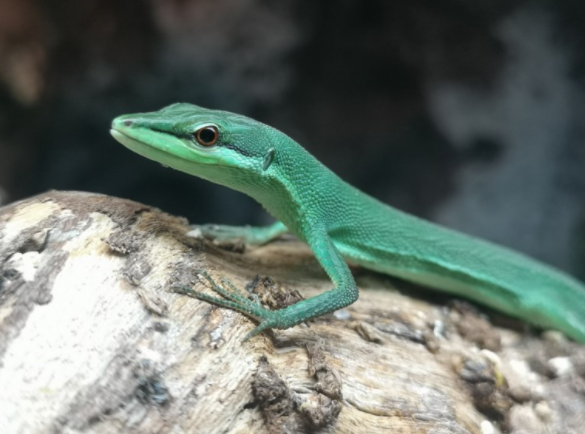
The Emerald Grass Skink, also known as the long-tailed skink, is a species originating from Japan. They are commonly found amongst trees, shrubs and other vegetation, and live an arboreal lifestyle. Emerald grass skinks are usually bright green in colour, with limited patterns. They have a very long thin tail that can stretch to more than twice the length of the body. This tail is used for balance to enable them in their extremely agile behaviours. Although quick and nimble, careful handling is possible, taking care not to damage their fragile limbs.
Housing
The Emerald Grass Skink is a very active lizard that requires a lot of space to move around. A minimum of 90 x 45 x 60cm should be provided to house up to four adults, although bigger is definitely appreciated. This will provide good opportunity for horizontal movement as well as their all-important arboreal habits. To begin with, your enclosure will need a good quality loose substrate such as soil – this will ensure moisture is held and will also provide the option of a live planted terrarium, which is much more natural and aesthetically pleasing. It may also be a good idea to think about a drainage layer, consisting of a layer of hydro rocks, matting and then your substrate – this will stop the soil from becoming waterlogged but also helps aid humidity in the tank by re-using the water that collects in the bottom layers.
To be sure that your skinks can make use of the entire enclosure, a lot of decor will need to be arranged inside the enclosure. It is essential that the climbing structure created is sturdy enough to hold the weight of the animal but also that it creates access to the higher portions of the tank, making heat and UV more accessible. For this, you could use a variety of branches, logs, vines and foliage.
To allow your skinks to take cover from heat and UV and hide from view, you should also use some of this decor to create sufficient ‘off show’ areas – for example, dense foliage over a branch to create a hidden area underneath. Being diurnally active, this won’t affect your viewing of your skinks as they will still venture out to bask and feed, and they are usually active animals.





